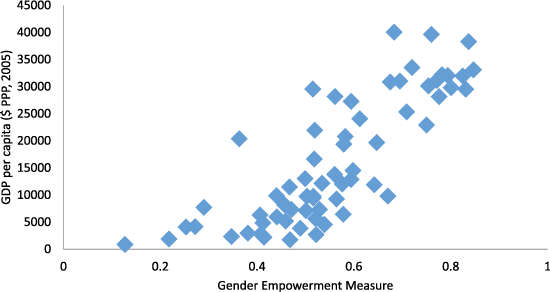
Female empowerment is associated with economic development, but cash transfers targeted at women may have unintended consequences
Successful economic development starts with decisions made within families. Improving the education and skills of the population, known as ‘human capital’, is a central factor in development. In large part, human capital depends on decisions made by parents, such as how many children to have, whether to send children to work or to school, and how much effort and money to put into their education. Physical capital is another critical factor for development. Again, families make the decisions on how much to save and consume that will ultimately determine the capital stock.
Getting families to 'do the right thing' is therefore important for development policy. How can this be done? According to recent conventional wisdom, the answer is to put women in charge. For example, the World Bank’s Gender Action Plan and the UN’s Millennium Development Goals both represent gender equality not just as a development objective in its own right, but also as an instrument to foster economic development.
A connection between empowerment and development
There are good reasons to believe that empowering women helps economic development. Reducing discrimination in access to education and the labour market would make better use of women’s skills and abilities. For example, Hsieh et al. (2013) found that in the US between 1960 and 2010, one-quarter of growth in output per capita was due to improved allocation of talent across genders and races, much of which was due to less discrimination. More generally, there is a strong empirical relationship between economic development and measures of gender equality. Figure 1 displays the cross-country relationship between income per capita and the Gender Empowerment Measure (GEM), constructed by the United Nations Development Program, which summarises a large set of indicators of gender equality.
Figure 1 Female empowerment (GEM) and economic development (GDP per capita in 2005) across countries

Note: GEM measures inequality between men’s and women’s opportunities, combining measures of inequality in political participation, economic participation, and power over economic resources. GDP per capita in international PPP dollars.
Source: UNDP (2005) and World Bank (2005).
Despite the strong association between female empowerment and development, we can't conclude that every empowerment initiative helps development. One type of policy that has recently gained popularity consists of cash loans or transfers provided exclusively to women. For example, from the late 1990s the PROGRESA programme in Mexico gave cash to women conditional on, among other things, keeping their children in school. Similar policies have been adopted by other countries. The majority of microfinance programmes around the world also provide funding exclusively to women.
Given that most of the women who receive the payments are married, their effects work through the balance of power and decision-making within the family. In recent work, we aim to understand the effects of these policies on economic development (Doepke and Tertilt 2016). Does providing resources only to women (rather than to their husbands or to both spouses) result in family decisions that help development?
How women and men spend the money
We already know from empirical research how income provided to wives, compared to husbands, affects family spending. Increases in women’s income appear to benefit children more than increases in men’s income (Thomas 1990, Hoddinott and Haddad 1995, Lundberg et al. 1997, Attanasio and Lechene 2002). Households in which women’s income share is higher spend a larger fraction of their income on children’s clothing and food, and children in these households are better fed. Some studies also find that households with a higher female income share spend less on alcohol and tobacco.
This suggests that men spend money for their own enjoyment, whereas women are more likely to invest in human capital by spending on children. If this were the entire story, putting as much resources as possible into the hands of women would be a promising development policy.
Our analysis, however, is more nuanced. The crucial issue is that women and men do not act independently, but interact within the household. We need to understand how wives and husbands bargain, and how this household bargaining process generates the observed spending patterns.
Explaining household spending
The most straightforward hypothesis asserts that women and men have different preferences, with women being more concerned about their children, and men their own wellbeing. Combine this with the assumption that women’s preferences matter more if their income share within the family goes up, and we get the spending patterns that we observe. According to this preference hypothesis, when giving transfers to women versus men, the trade-off is between additional spending on children versus private consumption of men.
There is a second possibility: the specialisation hypothesis. We develop a model of the household in which women and men specialise in different tasks, according to their comparative advantage. If women have lower wages than men, they specialise in time-intensive tasks, including childcare and food preparation. Men will take charge of tasks that require money but little time, such as saving and investing. If there are frictions and inefficiencies in household decision-making, a transfer targeted at one spouse will increase the expenditure share of the goods this in which this person specialises, and decrease the share of other goods. This would be true even if women and men had the same preferences.
Either hypothesis can account for the observation that transfers to women raise spending on children. According to the specialisation hypothesis, however, this increase comes at least in part at the expense of valuable goods provided by the husband, such as investments (say, in the family business) that would benefit the household in the future. If the specialisation hypothesis is true, it is no longer obvious whether targeting transfers to women benefits development. Indeed, we show that the overall impact depends on the relative importance of the goods provided by women and men for the growth process.
Evidence from PROGRESA
We use data from PROGRESA to search for evidence for the specialisation hypothesis. We use the staggered rollout of the programme, and the fact that only women received transfers, as a source of independent variation in women’s income share within the household, as in Attanasio and Lechene (2002). We find that a higher female income share is associated with more spending on children, as in existing research. But we also find that a higher female income share lowers household saving. This supports the specialisation hypothesis: There is a trade-off between development-relevant goods provided by women and men, rather than an unambiguous benefit from entrusting women with additional funds. The results are also consistent with other recent empirical findings on the important role of men for household saving and investment, such as de Mel et al. (2009), Robinson (2012), Fafchamps et al. (2014), and Haushofer and Shapiro (2016).
The preference hypothesis may also have a role to play. It is plausible that both mechanisms are relevant for explaining the data. But we should use caution over specific policy measures based solely on the preference hypothesis. There may be a strong correlation between female empowerment and development, but men also make important contributions within the family.
Lessons for policy and for research
There is little doubt that overall female empowerment helps development, but it is important to consider the different effects of empowerment before jumping to implement policy.
But, even more important, understanding what goes on within families is a crucial challenge for development economics. We know that many of the decisions that drive economic development are made in the family. We have ample evidence of frictions and potentially inefficient bargaining within families, and targeted transfers are only one example. Better models will be key if we want to improve our understanding of family decision-making and design policies that leverage the family’s role for economic development.
Photo credit: Son of Groucho/flickr.
References
Attanasio, O, and V Lechene (2002), “Tests of Income Pooling in Household Decisions”, Review of Economic Dynamics 5(4): 720–748.
de Mel, S, D McKenzie, and C Woodruff (2009), “Are Women More Credit Constrained? Experimental Evidence on Gender and Microenterprise Returns”, American Economic Journal: Applied Economics 1(3): 1–32.
Doepke, M and M Tertilt (2016), “Does Female Empowerment Promote Economic Development?” NBER Working Paper No. 19888.
Fafchamps, M, D McKenzie, S Quinn, and C Woodruff (2014), “Microenterprise Growth and the Flypaper Effect: Evidence from a Randomized Experiment in Ghana”, Journal of Development Economics 106: 211–226.
Haushofer, J, and J Shapiro (2016), “The short-term Impact of Unconditional Cash Transfers to the Poor: Experimental Evidence from Kenya”, Quarterly Journal of Economics 131(4): 1973-2042.
Hoddinott, J, and L Haddad (1995), “Does Female Income Share Influence Household Expenditures? Evidence from Cote D’Ivoire”, Oxford Bulletin of Economics and Statistics 57(1): 77–96.
Hsieh, C-T, E Hurst, C I Jones and P J Klenow (2013), “The Allocation of Talent and U.S. Economic Growth” NBER Working Paper No. 18693.
Lundberg, S J, R A Pollak, and T J Wales (1997), “Do Husbands and Wives Pool Their Resources? Evidence from the United Kingdom Child Benefit”, Journal of Human Resources 32 (3): 463–480.
Robinson, J (2012), “Limited Insurance within the Household: Evidence from a Field Experiment in Kenya”, American Economic Journal: Applied Economics 4(4): 140–64.
Thomas, D (1990), “Intra-Household Resource Allocation: An Inferential Approach”, Journal of Human Resources 25(4): 635–664.
United Nations Development Program (2005), Human Development Report 2005: International Cooperation at a Crossroads-Aid, Trade and Security in an Unequal World, New York: United Nations.
World Bank (2005), World Development Indicators, Washington, DC: World Bank.


